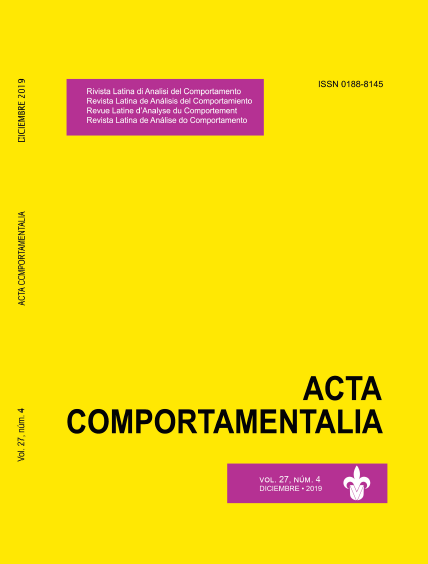Efectos de la demora sobre la respuesta de procuración u obtención en la acumulación de reforzadores
DOI:
https://doi.org/10.32870/ac.v27i4.72023Palabras clave:
delay of reinforcement, food accumulation, earn response, collect response, rats.Resumen
Most studies on food accumulation by rats involve two different response classes: earn and collect. However, in the majority of experiments accumulated food has only been delayed from the earn response. By contrast, the present study compared the effects of delayed reinforcement on both earn and collect responses. The procedure involved three successive components; an earn component in which earn responses increased the number of foods accumulated, a collect component where collect responses programmed the delivery of the reinforcers and a delay component the duration of which was lengthened to 0, 2, 4, 8, 16 and 32 s. The study compared two experimental conditions that differed only in the location of the delay component. For the earn condition, three rats each were exposed to a chained FI 30 s FT t FR1 while for the collect condition three different rats were each exposed to a chained FI 30 s FR1 FT t. For both conditions t was either 0, 2, 4, 8, 16, or 32. During the FI component, each lever press on the earn response increased the number of food pellets to be delivered at the end of the trial. Lengthening reinforcement delay in both conditions increased the number of accumulated food. Also, food accumulated per trial diminished along the session suggesting that rats could have satiated during the first trials thus decreasing the response rate of later trials. Results showed that delay of reinforcement have different effects on response rate depending on which response class is contingent to. If the delay follows the earn response, increasing delay gradients are obtained for the earn response while decreasing delay gradients are obtained for the collect response thus having two different delay gradients on the same subject. However, when the delay follows the collect response a decreasing delay gradient is obtained for the earn response. These findings replicate the results of other researchers showing that accumulated food increases as a function of the delay of reinforcement. However, even though the food accumulated increased in both conditions, response rate for the earn response only increased when the delay of reinforcement followed the earn component.
Descargas
Descargas
Publicado
Cómo citar
Número
Sección
Licencia

<a rel="license" href="http://creativecommons.org/licenses/by-nc-sa/4.0/"><img alt="Licencia de Creative Commons" style="border-width:0" src="https://i.creativecommons.org/l/by-nc-sa/4.0/88x31.png" /></a><br />Este obra está bajo una <a rel="license" href="http://creativecommons.org/licenses/by-nc-sa/4.0/">licencia de Creative Commons Reconocimiento-NoComercial-CompartirIgual 4.0 Internacional</a>.






